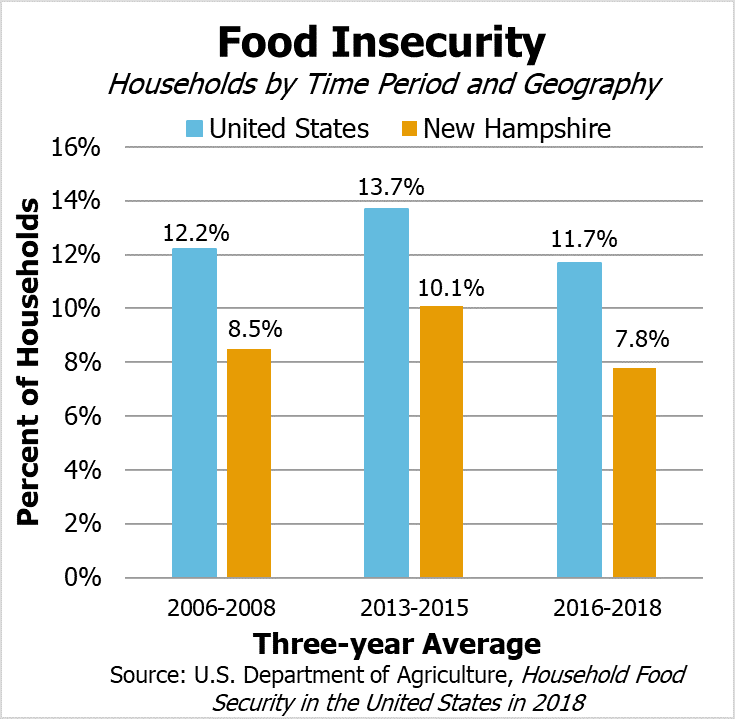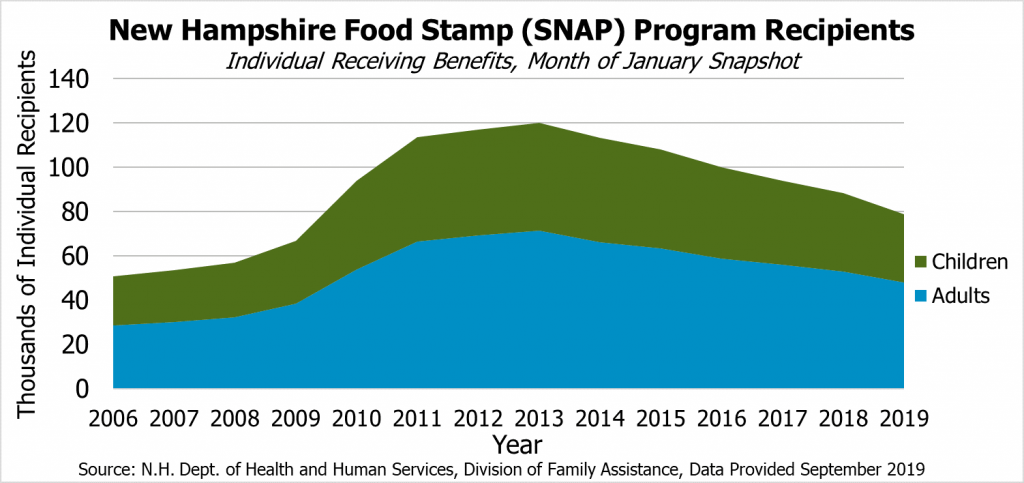According to new estimates from the United States Department of Agriculture (USDA), New Hampshire and the nation have experienced improvements in households’ access to food. The recently released report outlines the progressing trends of reduced food insecurity, declining from higher levels experienced in the recovery period after the Great Recession. This progress shows that despite disparities faced by lower-income individuals throughout the state, both relative improvements in the economy and the effectiveness of supplemental food programs have been aiding Granite Staters in need.
Data in this report are collected through the Current Population Survey’s Food Security Supplement. This questionnaire is distributed to households throughout the nation to estimate food security. According to the USDA, food insecurity means that “households were, at times, unable to acquire adequate food for one or more household members because they had insufficient money and other resources for food.” Households indicating conditions of food insecurity in the past 12 months are compiled across three-year periods; this time span is necessary at the state level to provide adequate data for meaningful analysis.
In New Hampshire, 7.8 percent of households were estimated to be food insecure over the 2016-2018 period. This represents about 41,800 households where food insecurity was reported at least once in the past year. This is a reduction from the higher levels of estimated food insecurity seen throughout the state from 2013 to 2015, where 10.1 percent of households were estimated to be food insecure. This decrease in food insecurity is a statistically significant change, as there is a high probability the sample data reflects an actual change in real conditions even when accounting for the limited sample sizes and the resulting margins of error. Compared to the 2006-2008 period, which includes the start of the Great Recession but not the low point in the state’s economy, 2016-2018 food insecurity levels have returned to pre-Recession levels after a long period of staying relatively elevated. Notably, there is no statistical difference between the levels of food insecurity between the 2006-2018 period and the 2016-2018 period in New Hampshire. When analyzing changes in households reporting very low food insecurity, defined as food insecurity combined with hunger, statistically significant decreases are estimated from the 2013-2015 period compared to the 2016-2018 period, but there is no statistical difference when comparing the 2006-2008 period and the 2016-2018 period.
Food insecurity in New Hampshire was estimated to affect approximately 7.4 percent of households in the 2004-2006 time period, which, when accounting for margin of error, is statistically indistinguishable from the 7.8 percent rate in the 2016-2018 data. These figures suggest food insecurity, after the longest economic expansion the United States has seen in the last 150 years, are finally dropping to pre-Recession levels.
Estimates for the nation show levels of food insecurity to be statistically higher than New Hampshire across recent periods, but the trends are similar. Data from the 2016-2018 period estimated 11.7 percent of households were food insecure. This translated to nearly 15 million households across the country. There were evident contrasts between those households that experienced food insecurity and those who did not. Households with lower incomes had higher rates of food insecurity, including an estimated 35.3 percent of households living with poverty-level incomes in 2018. About one in four households with children headed by a single woman, and one in five households with Black, non-Hispanic heads of household faced food insecurity nationally during 2018. Adults living alone, households with Hispanic heads of household, and households with children were all more likely to be food insecure than the population overall as well. In 2018, about 5.2 million households that were food insecure included children. In about 2.7 million households across the nation, the children living in these homes experienced food insecurity themselves.
Although estimated food insecurity has returned to pre-Recession levels, much can still be done to provide these struggling households with means to supplement their access to food. Recent trends in New Hampshire’s estimated food insecurity mirror that of enrollment levels in state’s Food Stamp Program, known nationally as the Supplemental Nutrition Assistance Program (SNAP). Key research establishes the link between SNAP and effective reductions in food insecurity.
With federally proposed rule changes aimed at modifying the eligibility guidelines of SNAP, portions of Granite Staters who utilize the program may end up in situations where they become food insecure. The current trend of decreasing levels of food insecurity is of paramount importance for the long-term well-being of individuals in New Hampshire and the nation. The proposed eligibility revisions have the potential to disenroll thousands of New Hampshire residents, conceivably plunging them into food insecurity. Future increases in levels of food insecurity across New Hampshire and the nation are a possibility if SNAP rule changes are enacted that will disenroll individuals and families from the program.
For more information on SNAP, see NHFPI’s March 2017 Fact Sheet, The New Hampshire Food Stamp Program. To learn more about the economic recovery and low-income residents in New Hampshire, see NHFPI’s August 2019 Issue Brief New Hampshire’s Workforce, Wages, and Economic Opportunity. For the most recently updated U.S. Census Bureau data detailing income and poverty figures for New Hampshire, see NHFPI’s September 26, 2019 Common Cents post New Census Bureau Data Show NH Incomes, Poverty Rates Holding Steady.
– Michael Polizzotti, Policy Analyst


